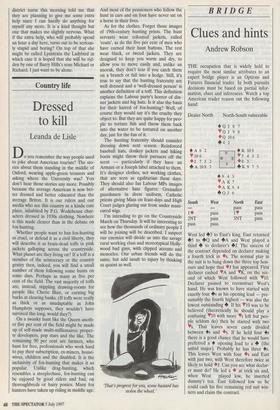Country life
Dressed to kill
Leanda de Lisle
Do you remember the way people used to joke about American tourists? The sto- ries about them standing in the middle of Oxford, wearing apple-green trousers and asking where the University was? You don't hear those stories any more. Possibly because the average American is now bet- ter dressed and better educated than the average Briton. It is our rulers and our media who see this country as a kinda cute place, inhabited by P.G. Wodehouse char- acters dressed in 1930s clothing. Nowhere is this made clearer than in the debate on fox-hunting.
Whether people want to ban fox-hunting as cruel, or defend it as a civil liberty, they will describe it as brain-dead toffs in pink jackets galloping across the countryside. What planet are they living on? If a toff is a member of the aristocracy or the country gentry then, indeed, you will find a small number of them following some hunts on some days. Perhaps as many as five per cent of the field. The vast majority of toffs are, instead, stippling drawing-rooms for people like Cherie Blair, or earning big bucks at clearing banks. (If toffs were really as thick or as unadaptable as John Humphrys supposes, they wouldn't have survived this long, would they?) On a swanky hunt like the Quorn anoth- er five per cent of the field might be made up of self-made multi-millionaires: proper- ty developers, pop stars and the like. The remaining 90 per cent are farmers, who hunt for free, professionals who work hard to pay their subscription, ex-miners, house- wives, children and the disabled. It is the inclusivity of fox-hunting that makes it so popular. Unlike drag-hunting, which resembles a steeplechase, fox-hunting can be enjoyed by good riders and bad, on thoroughbreds or hairy ponies. Many fox hunters have taken up riding in middle age. And most of the pensioners who follow the hunt in cars and on foot have never sat on a horse in their lives.
As for the clothes. Forget those images of 19th-century hunting prints. The hunt servants wear coloured jackets, called `coats', as do the five per cent of men who have earned their hunt buttons. The rest wear black, or tweed jackets. They are designed to keep you warm and dry, to allow you to move easily and, unlike an anorak, they don't tear if you catch them on a branch or fall into a hedge. Still, it's true to say that the hunting fraternity are well dressed and a 'well-dressed person' is another definition of a toff. This definition explains the Labour party's horror of din- ner jackets and big hats. Is it also the basis for their hatred of fox-hunting? Well, of course they would say it's the cruelty they object to. But they are quite happy for peo- ple to torture fish and throw them back into the water to be tortured on another day, just for the fun of it.
The hunting fraternity should consider dressing down next season. Reinforced baseball hats, donkey jackets and hiking boots might throw their pursuers off the scent — particularly if they have an Armani or a Joseph label attached to them. It's designer clothes, not working clothes, that are seen as egalitarian these days. They should also fax Labour MPs images of alternative hate figures: Grenadier guardsmen in dress uniform, Catholic priests giving Mass on feast-days and High Court judges glaring out from under mani- cured wigs.
I'm intending to go on the Countryside March on Thursday. It will be interesting to see how the thousands of ordinary people I will be joining will be described. I suspect our enemies will divide us into the savage rural working class and stereotypical Holly- wood bad guys, with clipped accents and monocles. Our urban friends will do the same, but add insult to injury by thinking us quaint as well.
`That's progress for you, some bastard has stolen the wheel.'


























































 Previous page
Previous page